Strategic Audit of Microsoft: Global Strategic Management Report
VerifiedAdded on 2022/12/15
|59
|16028
|394
Report
AI Summary
This report provides a comprehensive strategic audit of Microsoft, analyzing its global strategic management approach. It begins with an introduction and company background, followed by a detailed examination of Microsoft's business development history. The report then delves into industry analysis, competitor assessment (including Apple and Google), and the determination of industry competitiveness using Porter's Five Forces. External business factors, including political, economic, social, and technological influences, are evaluated. A financial analysis section covers key performance indicators, financial positions, and competitor comparisons, with estimations for future financial performance. The internal environment of Microsoft is analyzed, including its mission, goals, values, organizational structure, and functional strategies. The report also covers improvement initiatives, SWOT analysis, and strategic recommendations, such as implementing artificial intelligence, product diversification, and strategic alliances. The report concludes with a summary of findings and recommendations for Microsoft's future strategic direction.
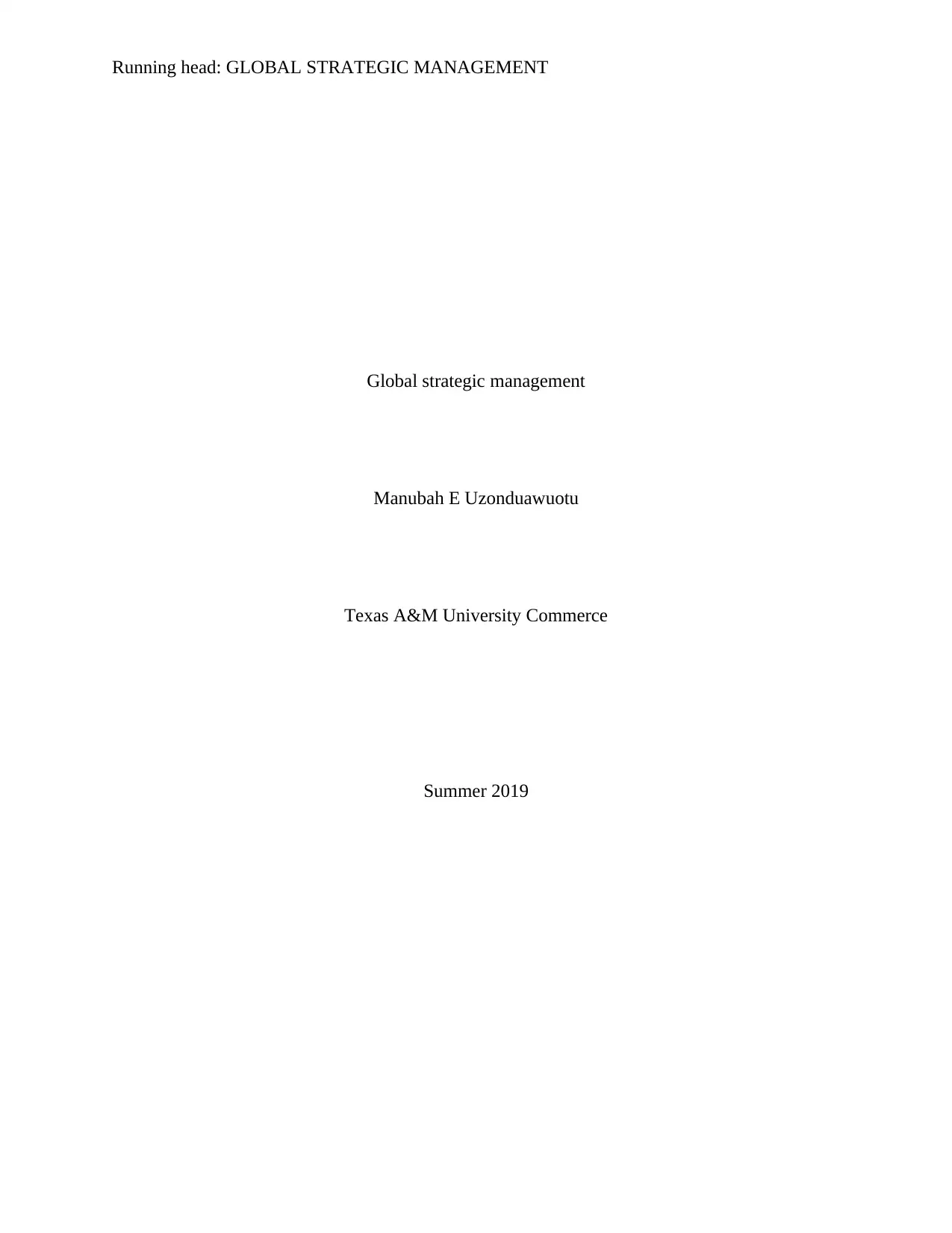
Running head: GLOBAL STRATEGIC MANAGEMENT
Global strategic management
Manubah E Uzonduawuotu
Texas A&M University Commerce
Summer 2019
Global strategic management
Manubah E Uzonduawuotu
Texas A&M University Commerce
Summer 2019
Paraphrase This Document
Need a fresh take? Get an instant paraphrase of this document with our AI Paraphraser
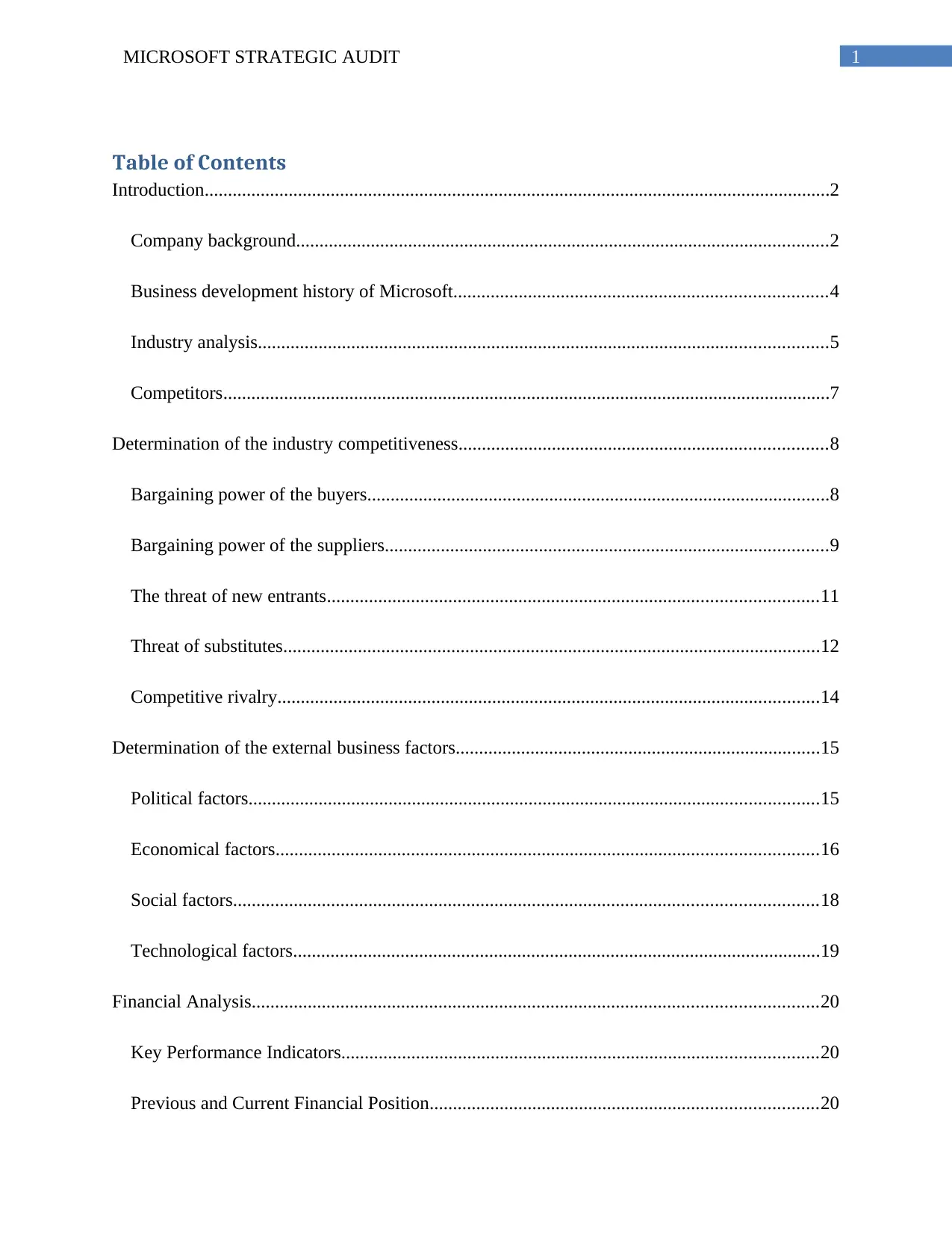
1MICROSOFT STRATEGIC AUDIT
Table of Contents
Introduction......................................................................................................................................2
Company background..................................................................................................................2
Business development history of Microsoft................................................................................4
Industry analysis..........................................................................................................................5
Competitors..................................................................................................................................7
Determination of the industry competitiveness...............................................................................8
Bargaining power of the buyers...................................................................................................8
Bargaining power of the suppliers...............................................................................................9
The threat of new entrants.........................................................................................................11
Threat of substitutes...................................................................................................................12
Competitive rivalry....................................................................................................................14
Determination of the external business factors..............................................................................15
Political factors..........................................................................................................................15
Economical factors....................................................................................................................16
Social factors.............................................................................................................................18
Technological factors.................................................................................................................19
Financial Analysis.........................................................................................................................20
Key Performance Indicators......................................................................................................20
Previous and Current Financial Position...................................................................................20
Table of Contents
Introduction......................................................................................................................................2
Company background..................................................................................................................2
Business development history of Microsoft................................................................................4
Industry analysis..........................................................................................................................5
Competitors..................................................................................................................................7
Determination of the industry competitiveness...............................................................................8
Bargaining power of the buyers...................................................................................................8
Bargaining power of the suppliers...............................................................................................9
The threat of new entrants.........................................................................................................11
Threat of substitutes...................................................................................................................12
Competitive rivalry....................................................................................................................14
Determination of the external business factors..............................................................................15
Political factors..........................................................................................................................15
Economical factors....................................................................................................................16
Social factors.............................................................................................................................18
Technological factors.................................................................................................................19
Financial Analysis.........................................................................................................................20
Key Performance Indicators......................................................................................................20
Previous and Current Financial Position...................................................................................20

2MICROSOFT STRATEGIC AUDIT
Operating Margin Performance.................................................................................................21
Profit Margin Performance........................................................................................................21
Return on Capital Invested Performance...................................................................................22
Current Ratio.............................................................................................................................23
Competitor Comparison.............................................................................................................24
Future Financial Performance Estimation.................................................................................25
Internal Environment Analysis of Microsoft.................................................................................26
Mission of Microsoft.................................................................................................................26
Goals of Microsoft.....................................................................................................................27
Values of Microsoft...................................................................................................................28
Microsoft’s Business and Organisational Structure......................................................................29
Functional Strategies of Microsoft................................................................................................32
Marketing...................................................................................................................................32
Finance.......................................................................................................................................33
Operations..................................................................................................................................34
Human Resources......................................................................................................................35
Information Technology............................................................................................................35
Improvement Initiatives undertaken by Microsoft........................................................................36
Best Practice Implementation....................................................................................................36
Cost Reduction...........................................................................................................................36
Operating Margin Performance.................................................................................................21
Profit Margin Performance........................................................................................................21
Return on Capital Invested Performance...................................................................................22
Current Ratio.............................................................................................................................23
Competitor Comparison.............................................................................................................24
Future Financial Performance Estimation.................................................................................25
Internal Environment Analysis of Microsoft.................................................................................26
Mission of Microsoft.................................................................................................................26
Goals of Microsoft.....................................................................................................................27
Values of Microsoft...................................................................................................................28
Microsoft’s Business and Organisational Structure......................................................................29
Functional Strategies of Microsoft................................................................................................32
Marketing...................................................................................................................................32
Finance.......................................................................................................................................33
Operations..................................................................................................................................34
Human Resources......................................................................................................................35
Information Technology............................................................................................................35
Improvement Initiatives undertaken by Microsoft........................................................................36
Best Practice Implementation....................................................................................................36
Cost Reduction...........................................................................................................................36
⊘ This is a preview!⊘
Do you want full access?
Subscribe today to unlock all pages.

Trusted by 1+ million students worldwide

3MICROSOFT STRATEGIC AUDIT
Quality Driven Management.....................................................................................................37
SWOT Analysis.........................................................................................................................37
Conclusion.....................................................................................................................................38
Strategic recommendations............................................................................................................39
Implementation of artificial intelligence...................................................................................39
Product diversification and innovative technologies.................................................................40
Strategic alliances with companies............................................................................................42
Addressing the increase in competition.....................................................................................44
Increasing the presence in smartphone industry........................................................................45
Reference.......................................................................................................................................48
Quality Driven Management.....................................................................................................37
SWOT Analysis.........................................................................................................................37
Conclusion.....................................................................................................................................38
Strategic recommendations............................................................................................................39
Implementation of artificial intelligence...................................................................................39
Product diversification and innovative technologies.................................................................40
Strategic alliances with companies............................................................................................42
Addressing the increase in competition.....................................................................................44
Increasing the presence in smartphone industry........................................................................45
Reference.......................................................................................................................................48
Paraphrase This Document
Need a fresh take? Get an instant paraphrase of this document with our AI Paraphraser
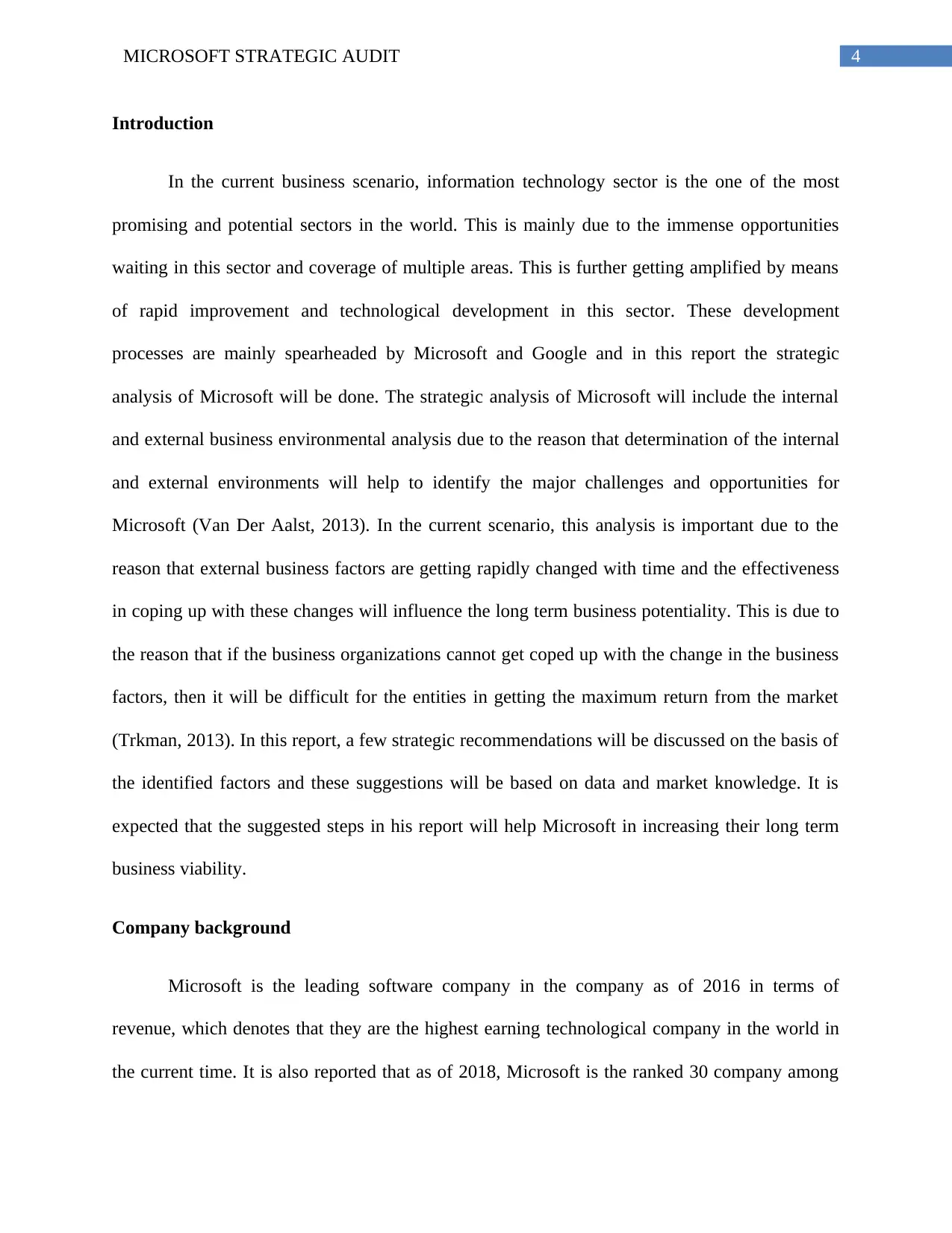
4MICROSOFT STRATEGIC AUDIT
Introduction
In the current business scenario, information technology sector is the one of the most
promising and potential sectors in the world. This is mainly due to the immense opportunities
waiting in this sector and coverage of multiple areas. This is further getting amplified by means
of rapid improvement and technological development in this sector. These development
processes are mainly spearheaded by Microsoft and Google and in this report the strategic
analysis of Microsoft will be done. The strategic analysis of Microsoft will include the internal
and external business environmental analysis due to the reason that determination of the internal
and external environments will help to identify the major challenges and opportunities for
Microsoft (Van Der Aalst, 2013). In the current scenario, this analysis is important due to the
reason that external business factors are getting rapidly changed with time and the effectiveness
in coping up with these changes will influence the long term business potentiality. This is due to
the reason that if the business organizations cannot get coped up with the change in the business
factors, then it will be difficult for the entities in getting the maximum return from the market
(Trkman, 2013). In this report, a few strategic recommendations will be discussed on the basis of
the identified factors and these suggestions will be based on data and market knowledge. It is
expected that the suggested steps in his report will help Microsoft in increasing their long term
business viability.
Company background
Microsoft is the leading software company in the company as of 2016 in terms of
revenue, which denotes that they are the highest earning technological company in the world in
the current time. It is also reported that as of 2018, Microsoft is the ranked 30 company among
Introduction
In the current business scenario, information technology sector is the one of the most
promising and potential sectors in the world. This is mainly due to the immense opportunities
waiting in this sector and coverage of multiple areas. This is further getting amplified by means
of rapid improvement and technological development in this sector. These development
processes are mainly spearheaded by Microsoft and Google and in this report the strategic
analysis of Microsoft will be done. The strategic analysis of Microsoft will include the internal
and external business environmental analysis due to the reason that determination of the internal
and external environments will help to identify the major challenges and opportunities for
Microsoft (Van Der Aalst, 2013). In the current scenario, this analysis is important due to the
reason that external business factors are getting rapidly changed with time and the effectiveness
in coping up with these changes will influence the long term business potentiality. This is due to
the reason that if the business organizations cannot get coped up with the change in the business
factors, then it will be difficult for the entities in getting the maximum return from the market
(Trkman, 2013). In this report, a few strategic recommendations will be discussed on the basis of
the identified factors and these suggestions will be based on data and market knowledge. It is
expected that the suggested steps in his report will help Microsoft in increasing their long term
business viability.
Company background
Microsoft is the leading software company in the company as of 2016 in terms of
revenue, which denotes that they are the highest earning technological company in the world in
the current time. It is also reported that as of 2018, Microsoft is the ranked 30 company among

5MICROSOFT STRATEGIC AUDIT
the Fortune 500 companies in the world. Microsoft was founded in 1975 in the United States.
Currently, the headquarters of Microsoft are in Redmond, Washington. As of now, Microsoft is
operating in both hardware and software market including manufacturing of different
technological devices and selling and licensing software and operating systems. The hardware
devices of Microsoft include gaming consoles, desktop, laptop, smartphone and tablets
computers. Major software of Microsoft includes Windows operating system, Internet explorer
browser and Office ranges. Thus, it can be concluded that there are different products and
services being offered by Microsoft and covering of larger market areas.
Analysis of the history of Microsoft identified that Bill Gates and Paul Allen started the
journey of this brand by developing devices for tracking traffic data. This further developed in to
personal computer space and the operating system business started. Zenix was the first operating
system introduced by Microsoft and it was first used in the IBM computers. In the later stage,
Windows operating system got introduced in the market by Microsoft and initiated the revolution
in the computing and technology sector (Sinha et al., 2015). The time period between 1995 and
2007 was the resurrection time for Microsoft due to the reason that this time periods witnessed
the rapid development of the Windows operating system and hardware and the entire computing
process. In addition, this is the time when Microsoft started to face the increasing competition in
their business. As of now, the overwhelming success of Microsoft is mainly due to the market
leadership status of the Windows as the key operating system for computers and the sales of
hardware. However, on the other hand, this should also be noted that there are number of
challenges being faced by Microsoft in the recent time and is mainly due to the reason that
Google and Apple have first emerged as the competitors for Microsoft. For example, Google’s
Android operating system is the market leader among the smartphones followed by Apple. Thus,
the Fortune 500 companies in the world. Microsoft was founded in 1975 in the United States.
Currently, the headquarters of Microsoft are in Redmond, Washington. As of now, Microsoft is
operating in both hardware and software market including manufacturing of different
technological devices and selling and licensing software and operating systems. The hardware
devices of Microsoft include gaming consoles, desktop, laptop, smartphone and tablets
computers. Major software of Microsoft includes Windows operating system, Internet explorer
browser and Office ranges. Thus, it can be concluded that there are different products and
services being offered by Microsoft and covering of larger market areas.
Analysis of the history of Microsoft identified that Bill Gates and Paul Allen started the
journey of this brand by developing devices for tracking traffic data. This further developed in to
personal computer space and the operating system business started. Zenix was the first operating
system introduced by Microsoft and it was first used in the IBM computers. In the later stage,
Windows operating system got introduced in the market by Microsoft and initiated the revolution
in the computing and technology sector (Sinha et al., 2015). The time period between 1995 and
2007 was the resurrection time for Microsoft due to the reason that this time periods witnessed
the rapid development of the Windows operating system and hardware and the entire computing
process. In addition, this is the time when Microsoft started to face the increasing competition in
their business. As of now, the overwhelming success of Microsoft is mainly due to the market
leadership status of the Windows as the key operating system for computers and the sales of
hardware. However, on the other hand, this should also be noted that there are number of
challenges being faced by Microsoft in the recent time and is mainly due to the reason that
Google and Apple have first emerged as the competitors for Microsoft. For example, Google’s
Android operating system is the market leader among the smartphones followed by Apple. Thus,
⊘ This is a preview!⊘
Do you want full access?
Subscribe today to unlock all pages.

Trusted by 1+ million students worldwide
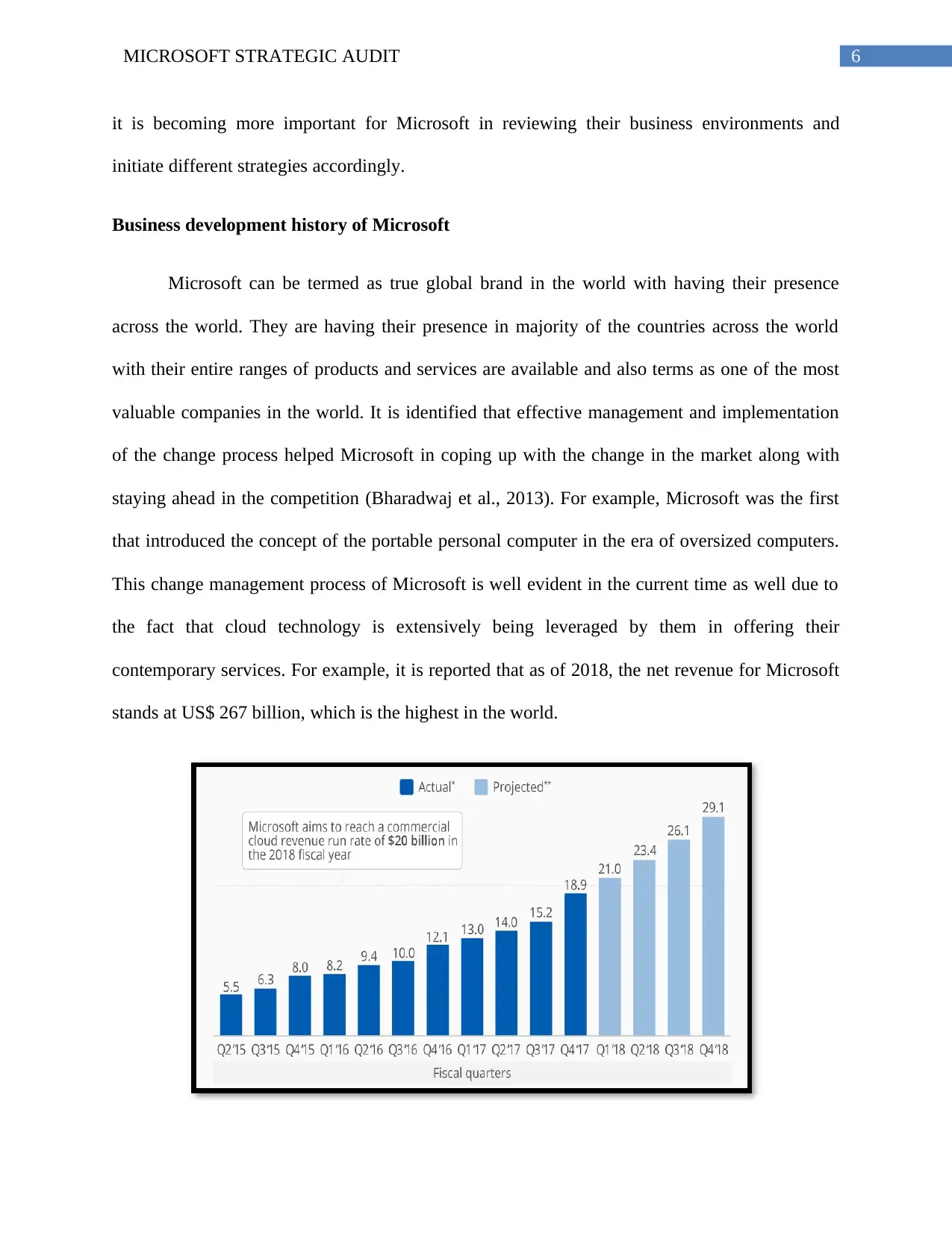
6MICROSOFT STRATEGIC AUDIT
it is becoming more important for Microsoft in reviewing their business environments and
initiate different strategies accordingly.
Business development history of Microsoft
Microsoft can be termed as true global brand in the world with having their presence
across the world. They are having their presence in majority of the countries across the world
with their entire ranges of products and services are available and also terms as one of the most
valuable companies in the world. It is identified that effective management and implementation
of the change process helped Microsoft in coping up with the change in the market along with
staying ahead in the competition (Bharadwaj et al., 2013). For example, Microsoft was the first
that introduced the concept of the portable personal computer in the era of oversized computers.
This change management process of Microsoft is well evident in the current time as well due to
the fact that cloud technology is extensively being leveraged by them in offering their
contemporary services. For example, it is reported that as of 2018, the net revenue for Microsoft
stands at US$ 267 billion, which is the highest in the world.
it is becoming more important for Microsoft in reviewing their business environments and
initiate different strategies accordingly.
Business development history of Microsoft
Microsoft can be termed as true global brand in the world with having their presence
across the world. They are having their presence in majority of the countries across the world
with their entire ranges of products and services are available and also terms as one of the most
valuable companies in the world. It is identified that effective management and implementation
of the change process helped Microsoft in coping up with the change in the market along with
staying ahead in the competition (Bharadwaj et al., 2013). For example, Microsoft was the first
that introduced the concept of the portable personal computer in the era of oversized computers.
This change management process of Microsoft is well evident in the current time as well due to
the fact that cloud technology is extensively being leveraged by them in offering their
contemporary services. For example, it is reported that as of 2018, the net revenue for Microsoft
stands at US$ 267 billion, which is the highest in the world.
Paraphrase This Document
Need a fresh take? Get an instant paraphrase of this document with our AI Paraphraser

7MICROSOFT STRATEGIC AUDIT
Figure: 1
Actual and projected cloud revenue of Microsoft
Source: (Richter, 2019)
According to the above figure, it is evident that Microsoft is on the track of achieving
their target from the cloud services. In addition, the projected revenue from the same services is
denoting that they have well forecasted that cloud services are the future sources of revenue.
However, on the other hand, it should also be noted that there are number of failed attempts also
occurred for Microsoft in terms of their business strategy (Pagani, 2013). For instance, merger
and acquisition is another widely used business strategy by Microsoft and acquisition of Nokia
cellular services is one of the major failed attempts in the recent business history. This is due to
the reason that Microsoft acquired the Nokia cellular services in order to gain the market share
among the fast growing smartphone segment. However, the forecasting approach of Microsoft in
this case got wrong and their Windows based mobile operating system offered lower value
propositions compared to the Android powered by Google (Vuori & Huy, 2016). This ultimately
led to the sale of the Nokia Brand to HMD global. Currently, Microsoft is not having their
presence in the smartphone sector, rather they are leveraging on the computer operating system.
Industry analysis
Even though, Microsoft is offering different hardware and software in the market, but
they are primarily operating in the operating system industry. According to the reports, the
worldwide sales of the operating system sales as of 2014 were US$ 32.8 billion. It is also
identified that Microsoft is having more than 75 percent of the market share compared to 12
percent market share of MAC OS by Apple (Gawer & Cusumano, 2014). Google is not having
Figure: 1
Actual and projected cloud revenue of Microsoft
Source: (Richter, 2019)
According to the above figure, it is evident that Microsoft is on the track of achieving
their target from the cloud services. In addition, the projected revenue from the same services is
denoting that they have well forecasted that cloud services are the future sources of revenue.
However, on the other hand, it should also be noted that there are number of failed attempts also
occurred for Microsoft in terms of their business strategy (Pagani, 2013). For instance, merger
and acquisition is another widely used business strategy by Microsoft and acquisition of Nokia
cellular services is one of the major failed attempts in the recent business history. This is due to
the reason that Microsoft acquired the Nokia cellular services in order to gain the market share
among the fast growing smartphone segment. However, the forecasting approach of Microsoft in
this case got wrong and their Windows based mobile operating system offered lower value
propositions compared to the Android powered by Google (Vuori & Huy, 2016). This ultimately
led to the sale of the Nokia Brand to HMD global. Currently, Microsoft is not having their
presence in the smartphone sector, rather they are leveraging on the computer operating system.
Industry analysis
Even though, Microsoft is offering different hardware and software in the market, but
they are primarily operating in the operating system industry. According to the reports, the
worldwide sales of the operating system sales as of 2014 were US$ 32.8 billion. It is also
identified that Microsoft is having more than 75 percent of the market share compared to 12
percent market share of MAC OS by Apple (Gawer & Cusumano, 2014). Google is not having
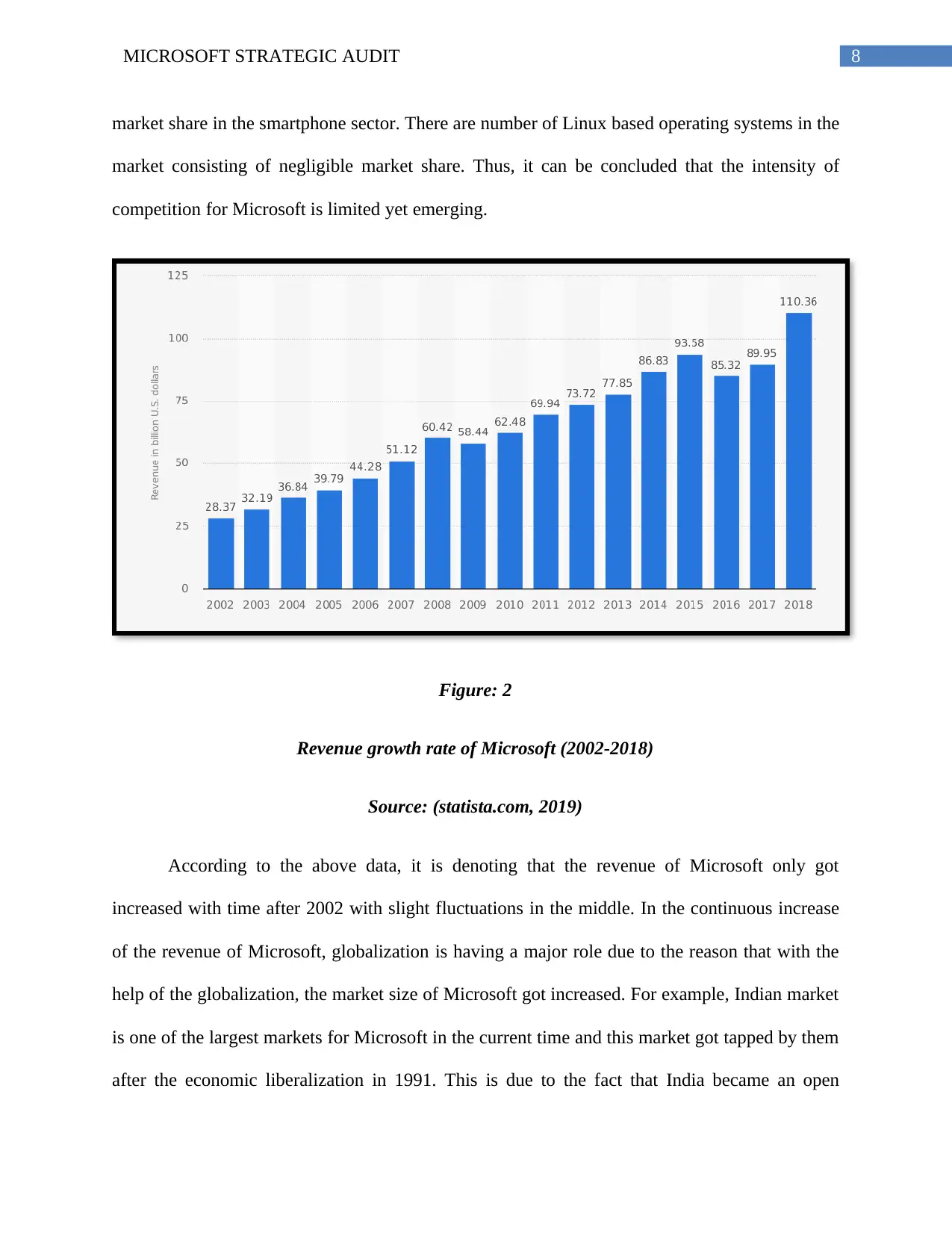
8MICROSOFT STRATEGIC AUDIT
market share in the smartphone sector. There are number of Linux based operating systems in the
market consisting of negligible market share. Thus, it can be concluded that the intensity of
competition for Microsoft is limited yet emerging.
Figure: 2
Revenue growth rate of Microsoft (2002-2018)
Source: (statista.com, 2019)
According to the above data, it is denoting that the revenue of Microsoft only got
increased with time after 2002 with slight fluctuations in the middle. In the continuous increase
of the revenue of Microsoft, globalization is having a major role due to the reason that with the
help of the globalization, the market size of Microsoft got increased. For example, Indian market
is one of the largest markets for Microsoft in the current time and this market got tapped by them
after the economic liberalization in 1991. This is due to the fact that India became an open
market share in the smartphone sector. There are number of Linux based operating systems in the
market consisting of negligible market share. Thus, it can be concluded that the intensity of
competition for Microsoft is limited yet emerging.
Figure: 2
Revenue growth rate of Microsoft (2002-2018)
Source: (statista.com, 2019)
According to the above data, it is denoting that the revenue of Microsoft only got
increased with time after 2002 with slight fluctuations in the middle. In the continuous increase
of the revenue of Microsoft, globalization is having a major role due to the reason that with the
help of the globalization, the market size of Microsoft got increased. For example, Indian market
is one of the largest markets for Microsoft in the current time and this market got tapped by them
after the economic liberalization in 1991. This is due to the fact that India became an open
⊘ This is a preview!⊘
Do you want full access?
Subscribe today to unlock all pages.

Trusted by 1+ million students worldwide

9MICROSOFT STRATEGIC AUDIT
economy from a closed economy after 1991 and this enabled Microsoft in entering the Indian
market and taps the emerging opportunities. Thus, the revenue and market size for Microsoft got
increased due to the role of globalization. On the other hand, it should also be noted that
globalization also increased the business complexities for Microsoft due to the reason that
different regions are having different sets requirements majorly from the operating systems
(Tseng, Liu & Wu, 2014). Different software is also having different levels of utilities in
different regions, which are also being managed by Microsoft. This is well evident in different
variants of technologies being offered by Microsoft.
Competitors
Apple
Apple is considered as the major competitors for Microsoft due to the reason that their
business model is similar to the latter. Apple is also having their own sets of hardware and
operating system and is rapidly emerging as the market challenger for Microsoft. One of the
major advantages of Apple over Microsoft is their extensive presence in the mobile sector. This
is due to the fact that Apple is selling millions of iphones across the world, which is not in the
case of Microsoft. As of now, Apple is having approx 12 percent of market share in the computer
operating system sector, while in the smartphone sector, it is approximately 18 percent (Zing et
al., 2015). Thus, it can be concluded that Apple is not having market leadership status in any of
the business sectors but is fast emerging and consisting a considerable market share. It is
predicted that with the introduction of the affordable products over their existing premium
products, this market share will get increased in the long term.
Google
economy from a closed economy after 1991 and this enabled Microsoft in entering the Indian
market and taps the emerging opportunities. Thus, the revenue and market size for Microsoft got
increased due to the role of globalization. On the other hand, it should also be noted that
globalization also increased the business complexities for Microsoft due to the reason that
different regions are having different sets requirements majorly from the operating systems
(Tseng, Liu & Wu, 2014). Different software is also having different levels of utilities in
different regions, which are also being managed by Microsoft. This is well evident in different
variants of technologies being offered by Microsoft.
Competitors
Apple
Apple is considered as the major competitors for Microsoft due to the reason that their
business model is similar to the latter. Apple is also having their own sets of hardware and
operating system and is rapidly emerging as the market challenger for Microsoft. One of the
major advantages of Apple over Microsoft is their extensive presence in the mobile sector. This
is due to the fact that Apple is selling millions of iphones across the world, which is not in the
case of Microsoft. As of now, Apple is having approx 12 percent of market share in the computer
operating system sector, while in the smartphone sector, it is approximately 18 percent (Zing et
al., 2015). Thus, it can be concluded that Apple is not having market leadership status in any of
the business sectors but is fast emerging and consisting a considerable market share. It is
predicted that with the introduction of the affordable products over their existing premium
products, this market share will get increased in the long term.
Paraphrase This Document
Need a fresh take? Get an instant paraphrase of this document with our AI Paraphraser
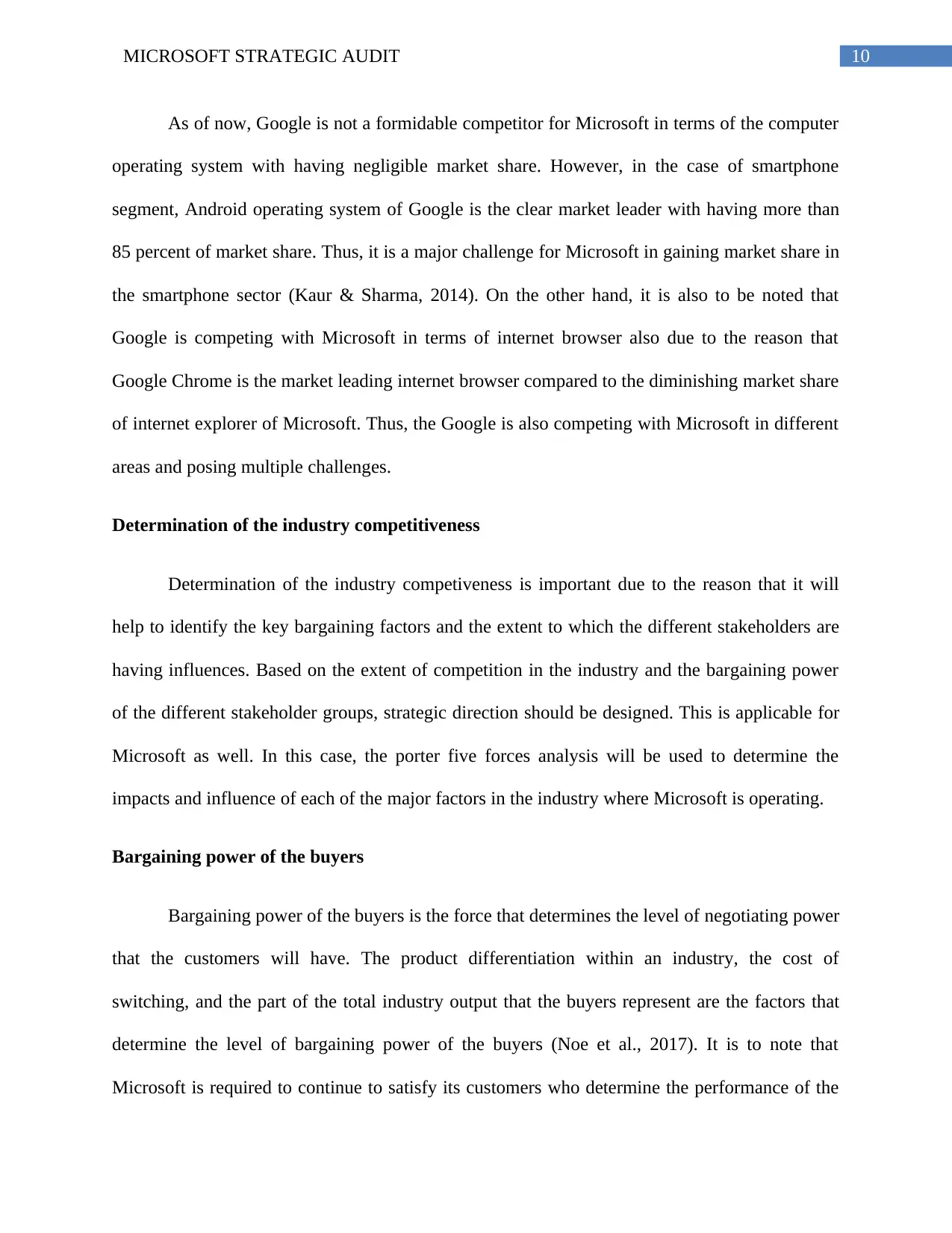
10MICROSOFT STRATEGIC AUDIT
As of now, Google is not a formidable competitor for Microsoft in terms of the computer
operating system with having negligible market share. However, in the case of smartphone
segment, Android operating system of Google is the clear market leader with having more than
85 percent of market share. Thus, it is a major challenge for Microsoft in gaining market share in
the smartphone sector (Kaur & Sharma, 2014). On the other hand, it is also to be noted that
Google is competing with Microsoft in terms of internet browser also due to the reason that
Google Chrome is the market leading internet browser compared to the diminishing market share
of internet explorer of Microsoft. Thus, the Google is also competing with Microsoft in different
areas and posing multiple challenges.
Determination of the industry competitiveness
Determination of the industry competiveness is important due to the reason that it will
help to identify the key bargaining factors and the extent to which the different stakeholders are
having influences. Based on the extent of competition in the industry and the bargaining power
of the different stakeholder groups, strategic direction should be designed. This is applicable for
Microsoft as well. In this case, the porter five forces analysis will be used to determine the
impacts and influence of each of the major factors in the industry where Microsoft is operating.
Bargaining power of the buyers
Bargaining power of the buyers is the force that determines the level of negotiating power
that the customers will have. The product differentiation within an industry, the cost of
switching, and the part of the total industry output that the buyers represent are the factors that
determine the level of bargaining power of the buyers (Noe et al., 2017). It is to note that
Microsoft is required to continue to satisfy its customers who determine the performance of the
As of now, Google is not a formidable competitor for Microsoft in terms of the computer
operating system with having negligible market share. However, in the case of smartphone
segment, Android operating system of Google is the clear market leader with having more than
85 percent of market share. Thus, it is a major challenge for Microsoft in gaining market share in
the smartphone sector (Kaur & Sharma, 2014). On the other hand, it is also to be noted that
Google is competing with Microsoft in terms of internet browser also due to the reason that
Google Chrome is the market leading internet browser compared to the diminishing market share
of internet explorer of Microsoft. Thus, the Google is also competing with Microsoft in different
areas and posing multiple challenges.
Determination of the industry competitiveness
Determination of the industry competiveness is important due to the reason that it will
help to identify the key bargaining factors and the extent to which the different stakeholders are
having influences. Based on the extent of competition in the industry and the bargaining power
of the different stakeholder groups, strategic direction should be designed. This is applicable for
Microsoft as well. In this case, the porter five forces analysis will be used to determine the
impacts and influence of each of the major factors in the industry where Microsoft is operating.
Bargaining power of the buyers
Bargaining power of the buyers is the force that determines the level of negotiating power
that the customers will have. The product differentiation within an industry, the cost of
switching, and the part of the total industry output that the buyers represent are the factors that
determine the level of bargaining power of the buyers (Noe et al., 2017). It is to note that
Microsoft is required to continue to satisfy its customers who determine the performance of the

11MICROSOFT STRATEGIC AUDIT
company. The impact that these customers have on the computer software and hardware industry
has been evaluated in the aspect of bargaining power. The size of the availability of the
substitute, the cost of switching and the quality of information determined the bargaining power
of the suppliers on the firm. It is to note that for Microsoft, the low availability of the substitute
is a weak force. This low availability of substitute showcase the problem in accessing the
adequate substitutes to the products of Microsoft. For instance, buyers face issues in finding out
the non-computer network solutions, which are efficient and effective as the products of the
company. It exerts weak forces on the company its environment.
Also, there are moderate switching costs of the suppliers and buyers for the firm, and this
further creates a significant force on the business of Microsoft. Due to the intensity of the
switching cost, the buyers have a tendency of shifting from the products supplied by Microsoft to
its rivalry companies. Moreover, there is a high quality of information, which is considered to be
a strong force for Microsoft (Fabbri&Klapper, 2016).This further empowers the customers in
terms of sufficient details and information that they can make use of for comparing the software
and hardware products of the company to the competitors. For example, such type of information
is very quickly present in the online sources. On the basis of the external factors that influence
the bargaining power of the buyers, Microsoft should also include this force to be a moderate
force and as a notable concern in the business strategies.
Bargaining power of the suppliers
It is to note that the business of Microsoft depends heavily on the supply conditions.
Bargaining power of the suppliers outlines the impacts of suppliers on the industry environment.
The size of the suppliers, their population and the overall supply maintain a low force of bargain
company. The impact that these customers have on the computer software and hardware industry
has been evaluated in the aspect of bargaining power. The size of the availability of the
substitute, the cost of switching and the quality of information determined the bargaining power
of the suppliers on the firm. It is to note that for Microsoft, the low availability of the substitute
is a weak force. This low availability of substitute showcase the problem in accessing the
adequate substitutes to the products of Microsoft. For instance, buyers face issues in finding out
the non-computer network solutions, which are efficient and effective as the products of the
company. It exerts weak forces on the company its environment.
Also, there are moderate switching costs of the suppliers and buyers for the firm, and this
further creates a significant force on the business of Microsoft. Due to the intensity of the
switching cost, the buyers have a tendency of shifting from the products supplied by Microsoft to
its rivalry companies. Moreover, there is a high quality of information, which is considered to be
a strong force for Microsoft (Fabbri&Klapper, 2016).This further empowers the customers in
terms of sufficient details and information that they can make use of for comparing the software
and hardware products of the company to the competitors. For example, such type of information
is very quickly present in the online sources. On the basis of the external factors that influence
the bargaining power of the buyers, Microsoft should also include this force to be a moderate
force and as a notable concern in the business strategies.
Bargaining power of the suppliers
It is to note that the business of Microsoft depends heavily on the supply conditions.
Bargaining power of the suppliers outlines the impacts of suppliers on the industry environment.
The size of the suppliers, their population and the overall supply maintain a low force of bargain
⊘ This is a preview!⊘
Do you want full access?
Subscribe today to unlock all pages.

Trusted by 1+ million students worldwide
1 out of 59
Related Documents
Your All-in-One AI-Powered Toolkit for Academic Success.
+13062052269
info@desklib.com
Available 24*7 on WhatsApp / Email
![[object Object]](/_next/static/media/star-bottom.7253800d.svg)
Unlock your academic potential
Copyright © 2020–2025 A2Z Services. All Rights Reserved. Developed and managed by ZUCOL.





